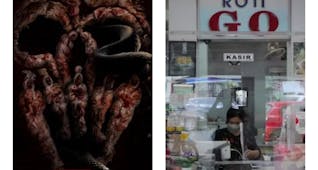by Tasa Nugraza Barley Foto diambil dari sini. In the world’s largest Muslim-majority country, it may come as a surprise to find Protestant and Catholic churches scattered throughout the archipelago. In Jakarta, two churches dating back to the early 19th century still stand, remnants of the former Portuguese and Dutch presence here and symbols of religious diversity in the country today. Just across from the country’s largest mosque, Mesjid Istiqial, in Central Jakarta, is Gereja Katedral, or the Jakarta Cathedral, a grand Catholic cathedral. The imposing neo-Gothic structure featuring twin spires was built in 1901, reconstructed from an older church built in the early 1800s by the Jesuit Ordo, a religious order of the Catholic Church. The cathedral’s vertical design differs from the wide construction of many of today’s churches and represents the church’s efforts to reach God, according to the cathedral’s priest, Justinus Sigit. Sigit points out that, like other Catholic churches, the cathedral is full of symbols that play a critical role in Catholic theology. “A lot of modern churches do not use many symbols anymore, and that’s a pity,” he says. When it was first built, the cathedral was named the Saint Maria Uplifted to Heaven, in honor of Saint Maria and her exceptional devotion to the church. “She is a perfect example of how a person can be so faithful to God,” Sigit says. Hadi Wahyu, the cathedral’s long-time caretaker, points to the cathedral’s tallest towers. The first tower to the left of the roof is a 60-meter-high structure called the David Fortress Tower. “This tower is a symbol of Saint Maria as the church’s guardian against the power of darkness,” Hadi explains. The other tower, the Ivory Tower, located on the right side of the roof, represents Saint Maria’s purity. “I don’t think there’s a church as beautiful as this one in Jakarta,” Hadi says. Inside the cathedral, rows of wooden pews accommodate about 800 people. On the walls are 14 paintings by Dutch artist Theo Molkenboer depicting the story of Jesus Christ’s crucifixion. “We call these paintings the Cross Journey,” Sigit says, explaining that Catholics regard the paintings as sacred and pray in front of each painting, while contemplating the suffering Jesus endured. Also inside the cathedral are candles, statues and flowers. Candles represent hope and they accompany prayer, Sigit says, “because we hope God will answer our prayers.” Flowers, too, are symbolic of God’s beauty, so worshipers often bring them when they come to pray, he adds. The cathedral also houses a museum on the second floor, which displays objects related to the church’s history in Jakarta. The collection includes several items from Pope Paul VI, who visited the cathedral in 1970, and Pope John Paul II, who visited in 1989. Strategically located in the heart of the city, the Jakarta Cathedral serves as an oasis for Christians, Sigit says. Mass occurs twice on weekdays and seven times on Sundays, but people come every day just to pray for a few minutes. “The church is a perfect escape for many people from the hectic life outside this building,” he says. Not far from the cathedral is a Protestant church, the Immanuel Church. Built in 1834 by the Dutch government, it was originally named the Williamskerk Church, in honor of King Willem I. “This is probably the only historic building in Jakarta that’s still used for what it was built for in the past,” says Ben Matulapelwa, a member of the church’s congregation. While parts of the church appear in need of renovation, Immanuel Church still retains some of its past glory. Six monumental pillars stand in front of the entrance to the beautiful white church, which is capped by a dome. Inside is a circular tile floor, beautiful wood carvings on the stair railing and intricately carved yellow ornaments on the ceiling. Peggy Klokke, another member of the congregation, says she prefers praying at Immanuel Church rather than at newer ones. The current trend among many Christians in Jakarta, especially young ones, is to go to modern churches with newer facilities. “I feel that there’s something special about this church that I don’t find in other churches,” she says. There is also a large old organ with more than 1,000 pipes. Made in 1843, the organ is still functional and is used on special occasions. “Many people come to the church just to see the organ,” Ben says. Surrounding Immanuel Church is a lovely, quiet garden that is conducive to prayer. “It is so peaceful to just sit and pray at this church,” Peggy says. Immanuel Church can hold up to 700 people, though for services during Christmas and other Christian holidays, the church, like Jakarta Cathedral, is usually packed with worshipers, and tents are set up to accommodate the crowds. During such holidays the churches usually receive extra protection from police because of occasional attacks and threats from Muslim extremists in the past. But for the most part, Sigit says, there is no animosity from worshipers at the nearby mosque. Visitors to the church often park in front of Mesjid Istiqial, which has a larger parking area, and the mosque has always permitted that. “We’ve done that for many years,” Sigit says. Hadi stresses the need to preserve Jakarta’s historic buildings, especially the cathedral, because it is a symbol of religious pluralism in the country. “Indonesia is a country where you have the freedom to practice your faith,” Hadi says. “There’s no reason that we should abandon our historical buildings, especially our historical churches.”
Cek berita, artikel, dan konten yang lain di Google News














